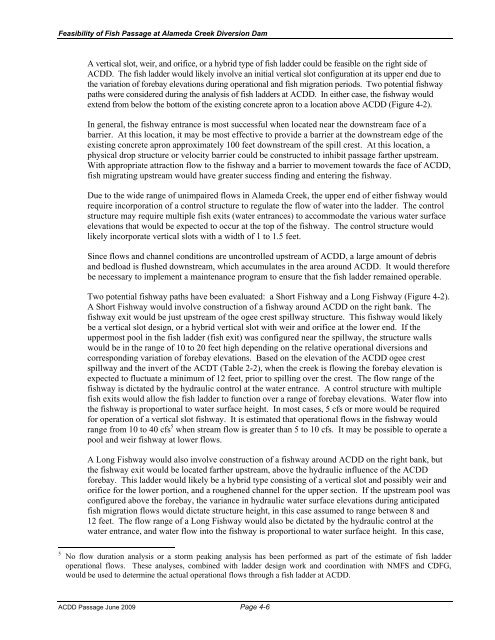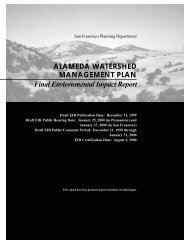Feasibility of Fish Passage at Alameda Creek Diversion Dam
Feasibility of Fish Passage at Alameda Creek Diversion Dam
Feasibility of Fish Passage at Alameda Creek Diversion Dam
You also want an ePaper? Increase the reach of your titles
YUMPU automatically turns print PDFs into web optimized ePapers that Google loves.
<strong>Feasibility</strong> <strong>of</strong> <strong>Fish</strong> <strong>Passage</strong> <strong>at</strong> <strong>Alameda</strong> <strong>Creek</strong> <strong>Diversion</strong> <strong>Dam</strong>A vertical slot, weir, and orifice, or a hybrid type <strong>of</strong> fish ladder could be feasible on the right side <strong>of</strong>ACDD. The fish ladder would likely involve an initial vertical slot configur<strong>at</strong>ion <strong>at</strong> its upper end due tothe vari<strong>at</strong>ion <strong>of</strong> forebay elev<strong>at</strong>ions during oper<strong>at</strong>ional and fish migr<strong>at</strong>ion periods. Two potential fishwayp<strong>at</strong>hs were considered during the analysis <strong>of</strong> fish ladders <strong>at</strong> ACDD. In either case, the fishway wouldextend from below the bottom <strong>of</strong> the existing concrete apron to a loc<strong>at</strong>ion above ACDD (Figure 4-2).In general, the fishway entrance is most successful when loc<strong>at</strong>ed near the downstream face <strong>of</strong> abarrier. At this loc<strong>at</strong>ion, it may be most effective to provide a barrier <strong>at</strong> the downstream edge <strong>of</strong> theexisting concrete apron approxim<strong>at</strong>ely 100 feet downstream <strong>of</strong> the spill crest. At this loc<strong>at</strong>ion, aphysical drop structure or velocity barrier could be constructed to inhibit passage farther upstream.With appropri<strong>at</strong>e <strong>at</strong>traction flow to the fishway and a barrier to movement towards the face <strong>of</strong> ACDD,fish migr<strong>at</strong>ing upstream would have gre<strong>at</strong>er success finding and entering the fishway.Due to the wide range <strong>of</strong> unimpaired flows in <strong>Alameda</strong> <strong>Creek</strong>, the upper end <strong>of</strong> either fishway wouldrequire incorpor<strong>at</strong>ion <strong>of</strong> a control structure to regul<strong>at</strong>e the flow <strong>of</strong> w<strong>at</strong>er into the ladder. The controlstructure may require multiple fish exits (w<strong>at</strong>er entrances) to accommod<strong>at</strong>e the various w<strong>at</strong>er surfaceelev<strong>at</strong>ions th<strong>at</strong> would be expected to occur <strong>at</strong> the top <strong>of</strong> the fishway. The control structure wouldlikely incorpor<strong>at</strong>e vertical slots with a width <strong>of</strong> 1 to 1.5 feet.Since flows and channel conditions are uncontrolled upstream <strong>of</strong> ACDD, a large amount <strong>of</strong> debrisand bedload is flushed downstream, which accumul<strong>at</strong>es in the area around ACDD. It would thereforebe necessary to implement a maintenance program to ensure th<strong>at</strong> the fish ladder remained operable.Two potential fishway p<strong>at</strong>hs have been evalu<strong>at</strong>ed: a Short <strong>Fish</strong>way and a Long <strong>Fish</strong>way (Figure 4-2).A Short <strong>Fish</strong>way would involve construction <strong>of</strong> a fishway around ACDD on the right bank. Thefishway exit would be just upstream <strong>of</strong> the ogee crest spillway structure. This fishway would likelybe a vertical slot design, or a hybrid vertical slot with weir and orifice <strong>at</strong> the lower end. If theuppermost pool in the fish ladder (fish exit) was configured near the spillway, the structure wallswould be in the range <strong>of</strong> 10 to 20 feet high depending on the rel<strong>at</strong>ive oper<strong>at</strong>ional diversions andcorresponding vari<strong>at</strong>ion <strong>of</strong> forebay elev<strong>at</strong>ions. Based on the elev<strong>at</strong>ion <strong>of</strong> the ACDD ogee crestspillway and the invert <strong>of</strong> the ACDT (Table 2-2), when the creek is flowing the forebay elev<strong>at</strong>ion isexpected to fluctu<strong>at</strong>e a minimum <strong>of</strong> 12 feet, prior to spilling over the crest. The flow range <strong>of</strong> thefishway is dict<strong>at</strong>ed by the hydraulic control <strong>at</strong> the w<strong>at</strong>er entrance. A control structure with multiplefish exits would allow the fish ladder to function over a range <strong>of</strong> forebay elev<strong>at</strong>ions. W<strong>at</strong>er flow intothe fishway is proportional to w<strong>at</strong>er surface height. In most cases, 5 cfs or more would be requiredfor oper<strong>at</strong>ion <strong>of</strong> a vertical slot fishway. It is estim<strong>at</strong>ed th<strong>at</strong> oper<strong>at</strong>ional flows in the fishway wouldrange from 10 to 40 cfs 5 when stream flow is gre<strong>at</strong>er than 5 to 10 cfs. It may be possible to oper<strong>at</strong>e apool and weir fishway <strong>at</strong> lower flows.A Long <strong>Fish</strong>way would also involve construction <strong>of</strong> a fishway around ACDD on the right bank, butthe fishway exit would be loc<strong>at</strong>ed farther upstream, above the hydraulic influence <strong>of</strong> the ACDDforebay. This ladder would likely be a hybrid type consisting <strong>of</strong> a vertical slot and possibly weir andorifice for the lower portion, and a roughened channel for the upper section. If the upstream pool wasconfigured above the forebay, the variance in hydraulic w<strong>at</strong>er surface elev<strong>at</strong>ions during anticip<strong>at</strong>edfish migr<strong>at</strong>ion flows would dict<strong>at</strong>e structure height, in this case assumed to range between 8 and12 feet. The flow range <strong>of</strong> a Long <strong>Fish</strong>way would also be dict<strong>at</strong>ed by the hydraulic control <strong>at</strong> thew<strong>at</strong>er entrance, and w<strong>at</strong>er flow into the fishway is proportional to w<strong>at</strong>er surface height. In this case,5 No flow dur<strong>at</strong>ion analysis or a storm peaking analysis has been performed as part <strong>of</strong> the estim<strong>at</strong>e <strong>of</strong> fish ladderoper<strong>at</strong>ional flows. These analyses, combined with ladder design work and coordin<strong>at</strong>ion with NMFS and CDFG,would be used to determine the actual oper<strong>at</strong>ional flows through a fish ladder <strong>at</strong> ACDD.ACDD <strong>Passage</strong> June 2009 Page 4-6








